In service 1936–1955 Entered service 1936-09-07 Number in service None | Number built 7 | |
 | ||
Manufacturer New Zealand Government Railways | ||
The NZR RM class Wairarapa railcar (or Rimutaka railcar) was the first truly successful class of railcars to operate on New Zealand's national rail network. They entered service in 1936 and were classified RM like all other classes of railcars in New Zealand; they came to be known as the "Wairarapa" class (and sometimes as the "Rimutaka" class) as they were designed to operate over the famous Rimutaka Incline to the Wairarapa region on the Wairarapa Line. They also acquired the nickname of "tin hares" in New Zealand railfan jargon. The first two to be introduced re-used the numbers RM 4 and RM 5 that had previously been used by the withdrawn experimental Model T Ford railcars. The class consisted of six passenger railcars, and one passenger-freight railcar. It is often described incorrectly as a class of six railcars.
Contents
Background
The Rimutaka Incline over the Rimutaka Ranges posed a severe time delay to any service operating between Wellington and the Wairarapa region. At one end of the Incline, a train had to have its engine replaced by multiple members of the H class, as the H class locomotives were specially designed to work the steep and difficult Incline. Once they hauled the train the length of the Incline, they were then replaced by a single ordinary engine, and the procedure to attach and remove the H class locomotives as well as the actual trip along the Incline was tremendously slow.
The Wairarapa railcars were designed as an answer to this problem. They were intended to operate along the length of the Incline and take over Wairarapa passenger services from regular carriage trains. In design, they resembled a bus, and unlike a usual single-unit railcar that has a driving compartment at each end, the Wairarapa railcars only had one driving end, necessitating that they be turned at the terminus of their journey. An additional characteristic of the Wairarapa railcars' design was that their body had to be built higher than an ordinary railcar to easily navigate the raised Fell centre rail on the Rimutaka Incline.
The first six of the class (Rm 4 to Rm 9) were designed to carry 49 passengers with their baggage. These were named after historic Maori canoes: Maahunui, Mahuhu, Mamari, Matahourua, Maatua, and Arai-te-Uru. A seventh railcar, Rm 10, named Arawa, was built as a mixed freight and passenger vehicle with seating for 25 passengers
Operation
Upon their introduction to service in 1936, the Wairarapa railcars proved to be the first successful class of railcars in New Zealand, although it is arguable that only the financial constraints of the Great Depression thwarted the success of the earlier Edison battery-electric railcar. The Wairarapa railcars immediately slashed running times between Wellington and the Wairarapa, and would operate the full length of the Wairarapa Line from Wellington to Woodville, and then utilise the Palmerston North - Gisborne Line through the Manawatu Gorge to access Palmerston North. They proved popular with passengers, fully replacing a locomotive-hauled carriage train known as the Wairarapa Mail in 1948, though local mixed trains continued to operate.
Withdrawal and preservation
The replacement of the Rimutaka Incline by the Rimutaka Tunnel in November 1955 meant that the main reason for the Wairarapa railcars' operation ceased to exist. Locomotive hauled trains were now competitive in timings with the railcars, which were soon withdrawn from service. By 1956, the six remaining cars were in storage at Hutt Workshops awaiting an uncertain future. They became increasingly derelict, as they were stored outside and enthusiasts often removed small parts as 'souvenirs' of the railcars.
In 1969, the Wellington Branch of the New Zealand Railway & Locomotive Society purchased the remains of RM 4, 5, 6, and 9 for preservation at their Gracefield site. To move the cars from Hutt Shops to Gracefield, the NZR&LS members physically shunted the railcars from the works to Gracefield, as the railcars' diesel engines were not at that time operable. When the group shifted to Seaview, RM 5 (by then working again) was used as an impromptu shunting engine to move the group's collection.
After arrival, it was decided to restore RM 5 Mahuhu to working order as it was felt to be in the best condition. RM 4 (which had been damaged in a level crossing collision before withdrawal), RM 6, and RM 9 Arai-te-uru were relegated to being spare parts sources.
RM 4 and RM 6 were scrapped in the 1970s after all re-usable components were stripped from their hulks, while RM 5 and RM 9 were placed into storage at the SSR. With no plans for the SSR to restore either, the decision was made in 1992 to lease RM 5 to the newly formed Pahiatua Railcar Society, who would then restore it to mainline operating standards. The car arrived at Pahiatua in 1992, and work began to slowly restore the car to operable condition.
As RM 5 was missing many parts, the decision was made in 2002 to acquire the remains of RM 9 for use as a spare parts source to complete the restoration of RM 5. Arriving in 2003, the incomplete frames of RM 9 became a source of spare parts that could be duplicated or restored for use on its sister car. There are no plans to restore RM 9 in its own right as a rail vehicle, and it will most likely be scrapped once it is no longer useful.
Originally, the 'Wairarapa' railcars had wooden internal framing covered with steel sheathing; however, RM 5's body had decayed so far the decision was made to replace the original wooden framing with steel. This improves the railcar's 'crash-worthiness', quite apart from being less maintenance-intensive. As of 2016, RM 5 was almost complete.[1]
